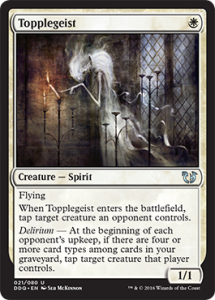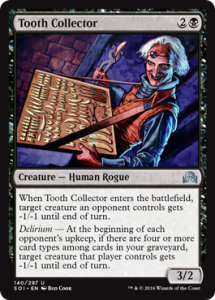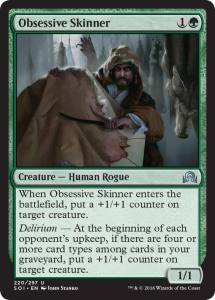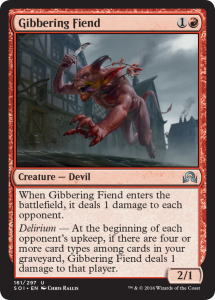Preparing for SOI Prerelease #1: Drifting into Delirium

With the eagerly-anticipated return to one of Magic’s most beloved planes mere days away, it’s time to take a look at what to expect as we dive into Shadows over Innistrad. At the time of writing this, we’re deep into spoiler season, and while we haven’t yet seen the full set list, we’ve got a pretty clear picture of the mechanics and archetypes that are going to make up what is shaping up to be one of the most exciting and deep limited sets in years.
To help you rise above the madness and keep a cool head as you go into your local pre-release, I’m going to explore some of the major themes and mechanics of SOI over the course of a few articles—starting with “Delirium”.
What is Delirium?
Delirium is a threshold style mechanic, that requires you to have four different card types among the cards in your graveyard to activate. When you have assembled these card types in your graveyard, any cards that have Delirium will start to yield powerful and often up-scaled effects.
Let’s look at one of my favourite delirium card so far as an example:
Descend upon the Sinful is a powerful board-wipe, the likes of which we’re pretty used to seeing. But, when you have met the requirements of Delirium, it becomes even better—leaving you with a 4/4 angel on the now empty board. That is a significant threat, and casting this spell with Delirium online will help you close games very quickly if your opponent doesn’t have an answer to it.
Where will you find Delirium?
Delirium as a mechanic doesn’t have any specific colour identity—it can be found on all five colours of cards. This is best illustrated by the cycle of powerful low-cost Delirium creatures found at uncommon in SOI.
Each of these creatures are “fine” on their own, but with Delirium enabled, become very very strong creatures in limited. However, this lack of specific colour identity shows us that Delirium itself isn’t really a “build around” mechanic—that is to say that you’re not really going to find yourself building a Delirium themed deck. Instead, it’s more of an upside for decks that are able to get it online.
So when should you play Delirium cards?
Delirium cards force you to think a bit more deeply about the rest of your available card pool. It’s not enough to just look at the card and consider if it’s powerful enough for your deck, instead you need to think about whether you have the cards to support the mechanic and get it online.
So let’s look at each individual card type and consider how you’re going to get one into your graveyard:
Creature: Trading with opponent’s creatures/having your creatures killed
Instant/sorcery: Just cast it
Land: Activating a sacrifice land such as Warped Landscape, or sacrificing lands to a unique effect
Enchantment: Using enchantments that are designed to hit the graveyard quickly, such as Dead Weight, or the “Vessel” cycle in SOI
Artifact: Slightly trickier (remember that clue tokens are tokens, and will not go to your graveyard when sacrificed)
Planeswalker: Having them die, although this seems suboptimal at best
That makes the Delirium threshold seem achievable, but there is one major way of fuelling it that I have overlooked…
Bringing method to your madness
The Madness mechanic has brought with it a huge number of discard outlets that you can use to make activating Delirium much easier. You choose what to discard, so you can fill in the gaps, and make tricky types like lands very easy to get into the graveyard.
The two mechanics of Delirium and Madness play together exceptionally well, so it’s well worth looking at the cards in your sealed pool with both mechanics and evaluating how well they could complement each other and synergise to grant you greater value.
With decent discard outlets, madness cards, and core support cards like Dead Weight, it’s not hard to image situations where you have Delirium online by around turn 4 or 5, and that could set you up for some very powerful plays in the turns that follow if you build your deck correctly.
Look out for more!
I hope that you found that short introduction to Delirium interesting. Keep your eyes peeled this week for more thoughts on the themes and mechanics of Shadows over Innistrad, and make sure you go into your pre-releases prepared!











